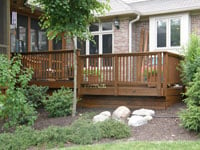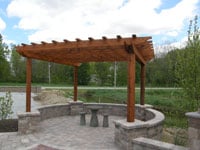FAQ
Home » FAQ
No problem. Our stains wipe off most metal, glass and non-porous surfaces with a simple rag.
Should stain get on other than intended surfaces, our professionals will remove it using our specially formulated EZ Clean. The cleaner was designed to remove overspray off windows, air conditioners, gutters, brick, cars, garage doors and pool equipment. We take pride in knowing that our jobs and the area around them are as clean or cleaner after we are finished.
- High quality, deep penetrating natural oils used to replenish and revive the composition of the wood.
- Highest quality trans-oxide and finely ground iron oxide pigments that lessen the damaging affect of harsh UV rays while providing ample color choices for consumers.
- UV inhibitors to further lessen the effects of harmful UV rays and keep the color consistent through the duration of the warranty.
- Synthetic resins designed to promote maximum adhesion and penetration to the wood while beautifying the finished appearance of the wood structure.
- The latest available mildewcides and fungicides to repel the growth of harmful mildew and fungus spores that decay wood and turn the fence gray in appearance.
- Water-repellent silicone to repel water, decreasing the damage associated with warping, swelling and cupping.
- Unique dispersants and anti-settling agents used to keep the product consistent in its container and lessen the amount of stirring required prior to application High quality, deep penetrating natural oils used to replenish and revive the composition of the wood.
Temperature does have an impact on staining results. The colder the temperature, the longer the drying time needed, the warmer the temperature, the less drying time is needed. Stains will work at 32 degrees Fahrenheit; however, higher temperatures provide better and faster results. 50 degrees Fahrenheit is the preferred industry standard due to a long history of applying stains & coatings. Temperature can be addressed in two areas, the substrate (wood) and the stain (liquid).
When applying stain to a substrate (wood), situations of entrapped moisture, decreased penetration or poor color development could occur. Since wood is a cellulose material made up of a “honey comb” matrix, the matrix is very fine fiber (varies with species of wood) and can be swelled in the presence of moisture, causing it to become more rigid (non-flexible) in colder temperatures. If the wood is cold and already filled with moisture (a detriment), it is less likely to absorb another liquid “stain”. Typically, the higher the substrates temperature the greater the stain will penetrate. Penetration is important in the protection and preservation of wood, the greater the penetration the longer protection and prevention of future inclusion of moisture/water.
All Liquids perform in varying degrees with temperature, like motor oil when heated up the thinner it becomes, when cold the thicker it becomes. Stains perform very much in the same manner, the warmer it is the thinner it becomes and the greater the opportunity for penetration which is the desired effect. In addition, the colder the stain (liquid) the more problems can be associated with color development, which has everything to do with flow and leveling of the stain (liquid). Additionally, some liquids in the stain, namely solvent and vehicle evaporate more evenly at elevated temperatures as opposed to cooler temperatures causing drying/curing issues, taking much longer to dry/cure in cooler temperatures that can also contribute to color development.
Testimonials

Tom Booker, Decks of Distinction

“Wood Medic, Inc. is an honest and loyal company going well beyond the norm to make sure the job is complete and the customer is happy. We haven’t had a single complaint from nearly 100 clients!”
Justin Rusher, Hittle Construction

